Introduction
Presty is a personal stylist application that makes use of modern generative AI technology to suggest all kinds of styling options for the user, including hair, facial hair, clothes, accessories, and more. The application also suggests new market products that suit the users needs. This project was done in a group (Peace Mfam~Onah, Devadhathan M D, Viral RajeshKumar Darji ) for User Experience Design and Service Design module for my MSc in User Experience Design. My role involved leading the team with ideation, research and prototyping.
The project followed the design thinking framework which involved the processes of ideation, empathising, planning, implementation, creation and evaluation of the project.
Ideation: How it Started
The idea for the application was brainstormed by the team. Hiring a personal stylist could be an expensive deal, one of the key advantages of technology is that it helps make exclusive products and services available to a wider audience, a trend seen from the industrial revolution, making clothes available to masses at a cheaper price by mechanising the process. The team decided to use the same idea to make personal styling available to the masses by using generative AI.
The features of the envisioned application were listed out through brainstorming and were prioritised to set realistic goals.

Empathising: The Research
The research phase of this project included research methods such as interviews and competitive analysis.
The user research method used for this project was interviewing potential users in person. The goals of the research were listed out and questions were framed to extract answers that match the research goals. Five participants were interviewed thoroughly. The transcripts were taken and analysed to form an affinity diagram that helped identify the themes within the conversations.

Personas
Two kinds of users were identified in this small research, two personas were created to represent each group of users. Scenarios were created to add context to the situation of the users. The PACT (People, Activities, Context, and Technologies) method was used in the process.


Empathy maps were created for the personas to empathise with the potential users and better understand their frustrations and needs.
A user journey map was created to visualize the user’s touchpoints and emotions when moving from one point to another.

Design & Implementation
The design phase of the project began with the creation of a screenflow diagram. this helped in visualising the flow the user would take to complete tasks when using the final application.

A service blueprint was created to illustrate the different stages of the business, the actions the user might take in each step, their emotions in each step, and the backstage actions the stakeholders will take to help the user progress through the blueprint.

Interface Design
The insights from the research were considered, and the ideas for each screen were sketched with pen and paper. Several versions of the same screen were sketched and the best sketch was chosen and modified with elements from other screen sketches that stood out. This helped in creating a refined interface through rough sketches.

A paper prototype was created and tested. After the success of the paper prototype, moodboards were created, illustrations were sorted and a high-fidelity prototype was created in Axure RP. The high fidelity prototype is highly interactive and uses the dynamic panel feature of Axure RP to create something very close to a minimum viable product as Axure can deal with inputs, data and more.
The Hi-Fi prototype can handle many features. The user first onboards the application by providing required measurements and information. Then the users are provided with insights about their body type and what styling options perfectly suit their bodies. The users can ask Presty for styling advice and chat with the intelligent application. users can also shop clothes and accessories from within the application by going to the store in person or through online mode. The users can also explore latest trends.
Conclusion
The project was developed into a high fidelity prototype from an abstract idea of an AI personal stylist. The key process involved was understanding the users deeply and adapting the initial idea to the insights from the user research to tailor the application for the users.
The design tool Axure RP was used to implement the high fidelity prototypes. Features such as dynamic panel and interactive input fields were used to create interactive interfaces which even made use of the data input from the user. The interface design could be improved in the future.


